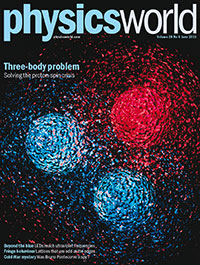By Matin Durrani
For nearly three decades, physicists have been unable to answer a seemingly simple question: where does proton spin come from? Adding up the spins of the three quarks that make up the proton seems, in principle, straightforward, but physicists have been struggling with a strange problem: the sum of the spins of its three quarks is much less than the spin of the proton itself.

Known as the “spin crisis”, the topic appears as the cover story of the June 2015 issue of Physics World, which is out now in print and digital formats. In the feature article, science writer Edwin Cartlidge examines the origins of the problem – and whether new experiments could mean we are about to solve it at last.
If you’re a member of the Institute of Physics (IOP), you can get immediate access to the feature with the digital edition of the magazine on your desktop via MyIOP.org or on any iOS or Android smartphone or tablet via the Physics World app, available from the App Store and Google Play. If you’re not yet in the IOP, you can join as an IOPimember for just £15, €20 or $25 a year to get full digital access to Physics World.
The issue also includes a great Lateral Thoughts article by Felix Flicker that’ll have you twisting and bending your arms as you try to follow what he’s on about.
For the record, here’s a rundown of what else is in the issue.
• UK to host SKA headquarters – Giant radio telescope’s HQ will be at Jodrell Bank, despite a “compelling” bid from its rival, as Edwin Cartlidge reports
• STEM paradox revisited – Matin Durrani on why employers struggle to find physicists when many physicists can’t find jobs
• Black elephants – Robert P Crease writes about scientific rituals that we recognize but don’t talk about
• Plugging the gap – Accelerator science plays an important part in basic science, medicine and industry, but as Carsten Welsch warns, a skills shortage threatens progress
• The spin of a proton – For the best part of 30 years physicists have been unable to answer a seemingly simple question: where does proton spin come from? As Edwin Cartlidge reports, the answer may finally be within reach
• Through a glass, darkly – The story of light-emitting diodes is one of creeping ever
further up the frequency spectrum. With several big semiconductor firms now mass-producing light-emitting diodes in the ultraviolet range, these devices are set to replace mercury-vapour lamps in a range of applications. Richard Corfield reports
• Edging into the spotlight – Stephen Ornes explores the strange properties of lattices that are bendy at the edges but not in the bulk, and how they could inspire novel metamaterials that can store data or lead to building materials that only fail in predictable ways
• Tinker, tailor, physicist, spy? – Simon Turchetti reviews Half-Life: the Divided Life of Bruno Pontecorvo, Physicist or Spy by Frank Close
• The cradle of science – Paul Montgomery reviews To Explain the World: the Discovery of Modern Science by Steven Weinberg
• Ruling the seas – Paul Featonby from Tracerco explains how a background in physics has helped him design and build undersea diagnostic equipment for the oil and gas industry
• Once a physicist – Roma Agrawal on her life as a structural engineer
• The weirdness of timezones – Felx Flicker on the art of transporting things when space is curved
Guidelines
Show/hide formatting guidelines
this text was deletedwhere people live in harmony with nature and animals</q>
Some text